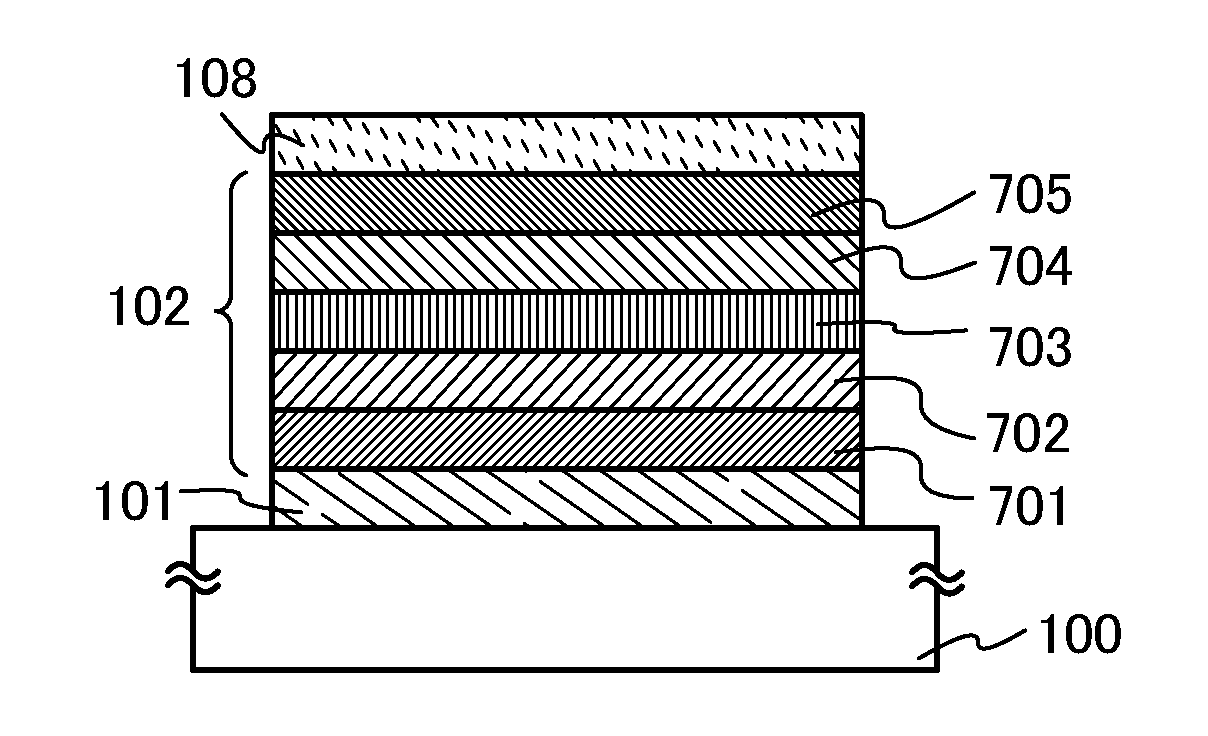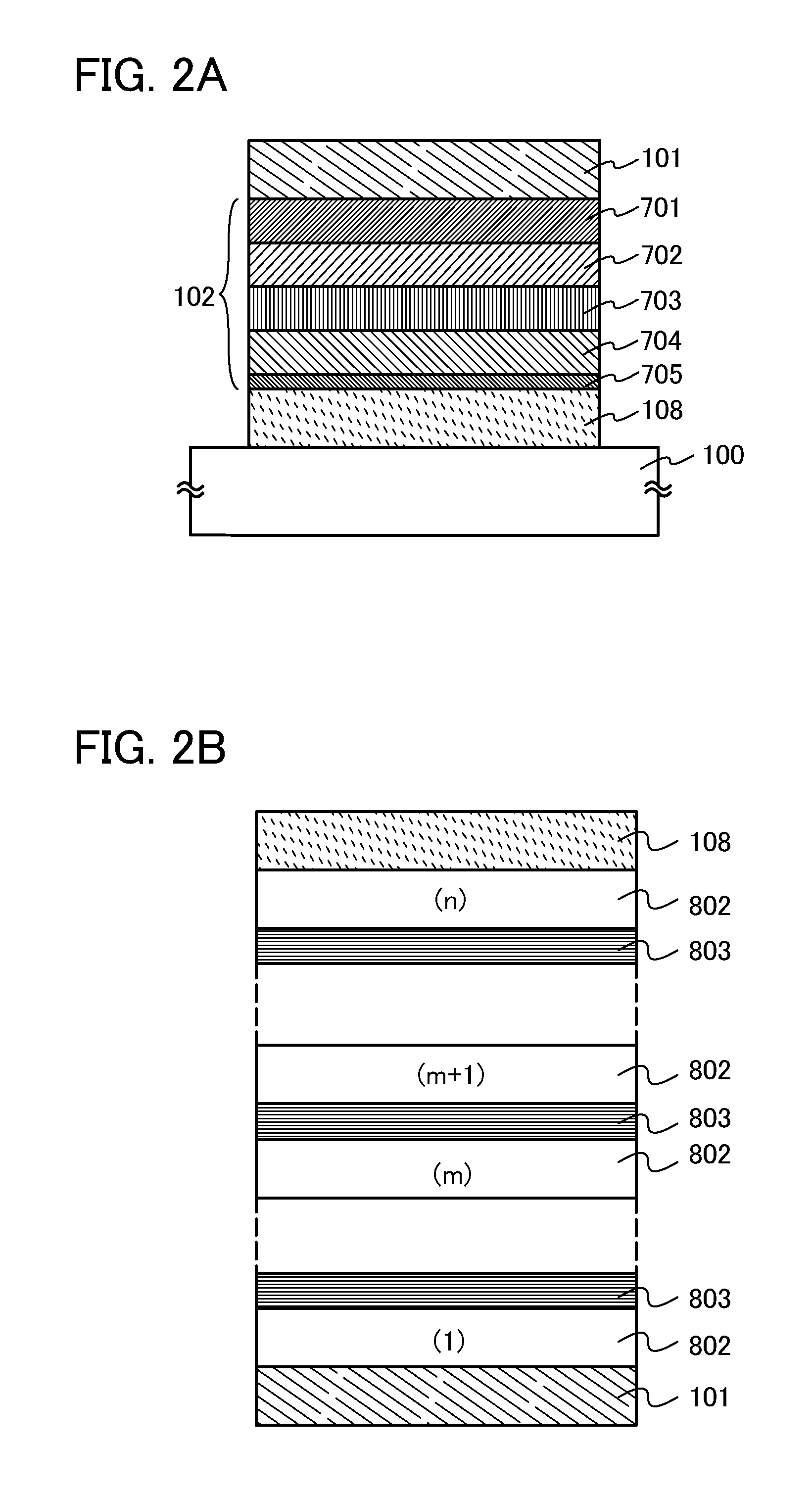Composite material, light-emitting element, light-emitting device, electronic device, lighting device, and organic compound
a technology of light-emitting elements and composite materials, which is applied in the direction of oxide conductors, conductors, non-metal conductors, etc., can solve the problems of low transmittance, inability to efficiently extract light generated within the element, and inability to achieve efficient extraction of light, etc., to achieve excellent carrier injection properties, high visible light-transmitting properties, and high transport properties
- Summary
- Abstract
- Description
- Claims
- Application Information
AI Technical Summary
Benefits of technology
Problems solved by technology
Method used
Image
Examples
embodiment 1
[0091]In this embodiment, a composite material of one embodiment of the present invention will be described.
[0092]A composite material of one embodiment of the present invention is a composite material of an organic compound having a particular skeleton and an inorganic compound. There is no limitation on a method of preparing the composite material of one embodiment of the present invention; for example, it can be formed by a co-evaporation method in which the organic compound and the inorganic compound are deposited at the same time. The mixing ratio, in mass ratio, of the organic compound to the inorganic compound in the composite material of one embodiment of the present invention is preferably approximately 8:1 to 1:2 (=Organic compound: inorganic compound), and more desirably, 4:1 to 1:1 (=Organic compound: inorganic compound). When the composite material is formed by a co-evaporation method, the mixing ratio can be controlled by separately adjusting the deposition rates for t...
embodiment 2
[0114]In this embodiment, a light-emitting element of one embodiment of the present invention will be described with reference to FIGS. 1A to 1C.
[0115]In a light-emitting element of this embodiment, an EL layer (a layer containing a light-emitting substance) is interposed between a pair of electrodes. The EL layer includes at least a layer containing the composite material of one embodiment of the present invention described in Embodiment 1 and a light-emitting layer. The EL layer may additionally include another layer. For example, the EL layer may include a layer containing a substance having a high carrier-injection property or a layer containing a substance having a high carrier-transport property so that a light-emitting region is formed in a region away from the electrodes, that is, so that carriers recombine in a region away from the electrodes. In this specification, the layer containing a substance having a high carrier-injection or a high carrier-transport property is also...
embodiment 3
[0175]In this embodiment, a light-emitting device including a light-emitting element of one embodiment of the present invention will be described with reference to FIGS. 3A and 3B. FIG. 3A is a top view illustrating a light-emitting device. FIG. 3B is a cross-sectional view taken along lines A-B and C-D in FIG. 3A.
[0176]The light-emitting device of this embodiment includes a source side driver circuit 401 and a gate side driver circuit 403 which are driver circuit portions, a pixel portion 402, a sealing substrate 404, a sealant 405, a flexible printed circuit (FPC) 409, and an element substrate 410. A portion enclosed by the sealant 405 is a space.
[0177]Note that a lead wiring 408 is a wiring for transmitting signals that are to be inputted to the source driver circuit 401 and the gate driver circuit 403, and receives a video signal, a clock signal, a start signal, a reset signal, and the like from an FPC 409 which serves as an external input terminal. Although only the FPC is illu...
PUM
| Property | Measurement | Unit |
|---|---|---|
| transmittance | aaaaa | aaaaa |
| visible-light wavelengths | aaaaa | aaaaa |
| work function | aaaaa | aaaaa |
Abstract
Description
Claims
Application Information
 Login to View More
Login to View More - R&D
- Intellectual Property
- Life Sciences
- Materials
- Tech Scout
- Unparalleled Data Quality
- Higher Quality Content
- 60% Fewer Hallucinations
Browse by: Latest US Patents, China's latest patents, Technical Efficacy Thesaurus, Application Domain, Technology Topic, Popular Technical Reports.
© 2025 PatSnap. All rights reserved.Legal|Privacy policy|Modern Slavery Act Transparency Statement|Sitemap|About US| Contact US: help@patsnap.com



